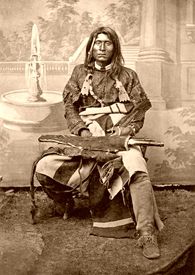The Modoc Campaign of 1872-73 was the last Indian War of consequence on the Pacific Coast. When the Modoc, a small and restless tribe, were placed on a reservation with the Klamath, their traditional enemies, they soon found the situation intolerable. Most of the Modoc soon left the reservation, led by a chief known as “Captain Jack,” and returned to their old lands. A detail of 1st Cavalry troops under Captain James Jackson became involved in a skirmish with these Modoc on Lost River on November 29, 1872, when the troops sought to disarm them and arrest the leaders.
Following the skirmish, Captain Jack and about 120 warriors with ample supplies retreated to a naturally fortified area in the Lava Beds east of Mount Shasta. On January 17, 1873, Colonel Alvan Gillem’s detachment of some 400 men, half of them Regulars from the 1st Cavalry and 21st Infantry, attacked the Modoc positions. However, the troops could make no progress in the almost impassable terrain, suffering a loss of 10 killed and 28 wounded.
By the spring of 1873, Brigadier General Edward R. S. Canby, commander of the Department of the Pacific, had collected about 1,000 men to besiege the Modoc. Indian Bureau officials failed in attempts at negotiation, but General Canby and three civilian commissioners were able to arrange a parley with an equal number of Modoc representatives on 11 April. The Indians treacherously violated the truce. Captain Jack killed General Canby, while others killed one commissioner, Eleazer Thomas, and wounded another. The siege was resumed.
Brigadier General Jefferson C. Davis, who arrived in May to replace Canby, pushed columns deep into the Lava Beds, hurrying the Indians day and night with mortar and rifle fire. When their water source was cut off, the Indians were finally forced into the open, and all were captured by June 1, 1873. Captain Jack and two others were hanged, and the rest of the tribe was removed to the Indian Territory. During the course of the siege, some 80 white men were killed.
Compiled and edited by Kathy Alexander/Legends of America, updated December 2022.
Also See:
Battles and Massacres of the Indian Wars

